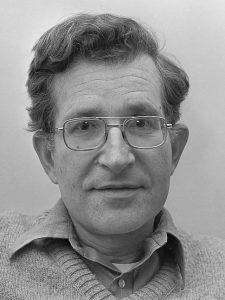24 Topics in Cognitive Psychology
Language Acquisition
Noam Chomsky (1928-)

Noam Chomsky, the father of modern linguistics, developed the dominant theory on human language acquisition.
Chomsky was born in Philadelphia, Pennsylvania to a Russian-Jewish family (Barsky, 1998). Chomsky’s father was a scholar who researched and wrote about ancient Hebrew, while his mother was a Hebrew teacher. Chomsky’s family greatly influenced his late intellectual life. Chomsky began his education early, attending school right before his second birthday. In 1945, at the age of sixteen, Chomsky began his undergraduate in general studies at the University of Pennsylvania. He became highly interested in linguistics and decided to pursue a doctorate in linguistics at the same university, and he completed both his Master’s and Ph.D. there by 1955. After graduation, Chomsky worked as a professor at the Massachusetts Institute of Technology, where he taught language and philosophy courses. There, Chomsky developed his theory of language acquisition.
Chomsky’s theory of language acquisition contrasted the old linguistic beliefs of his university professors and other linguists. Linguists before Chomsky believed that children were born with little to no innate knowledge and learned language through conditioning. Unlike his linguist predecessors, Chomsky believed that humans are born with a language acquisition device, which allows humans to learn and speak their language quickly (Theories, n.d.). Chomsky’s theory has several pieces of evidence. Firstly, language learning does not happen at the same rate throughout a human’s life. The critical period for language learning occurs in early childhood, before the age of 7. If a child is not exposed to language during this time, the child will never fully possess the same language levels as a normally developed individual. For example, Genie, a girl living in isolation until the age of 13, never fully learned to speak fluently and without error, even when she was taught English after her rescue. Secondly, human anatomy is fit for language production, as we have developed vocal cords for producing articulate speech, unlike our nearest chimp relatives. Humans also have brain areas specifically dedicated to language learning and production. Other evidence for the language acquisition device includes the creation of creole languages* and sign language.**Chomsky also countered the views of behaviourist B.F. Skinner, who believed that humans learned language through imitation and reinforcement (Theories, n.d.). Language cannot be learned through imitation because children create their own sentences that adults would never say (ex: “I eated the apple”) and adults do not always speak clearly enough to learn by proper imitation (stuttering, etc.).
Chomsky’s thinking was met with a wave of backlash, however, his theory remains the dominant one on language acquisition. Today, Chomsky is a well-renowned researcher, author and political activist.
References
Barsky, R. F. (1998). Noam Chomsky: A life of dissent. MIT Press.
Berwick, R. C., Friederici, A. D., Chomsky, N., & Bolhuis, J. J. (2013). Evolution, brain, and the nature of language. Trends in cognitive sciences, 17(2), 89-98.
Theories of Language Aquisition (n.d.). https://www.montsaye.northants.sch.uk/assets/Uploads/English-Language-Summer-Work-2.pdf
Further Reading
*Bickerton, D. (1983). Creole languages. Scientific American, 249(1), 116-123.
Chomsky, N. (2002). On nature and language. Cambridge University Press.
Hurford, J. R. (1991). The evolution of the critical period for language acquisition. Cognition, 40(3), 159–201. https://doi.org/10.1016/0010-0277(91)90024-x
Pinker, S. (1994). The language instict : how the mind creates language. Harper Perennial.
